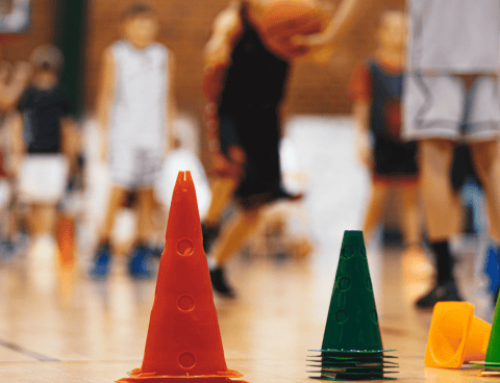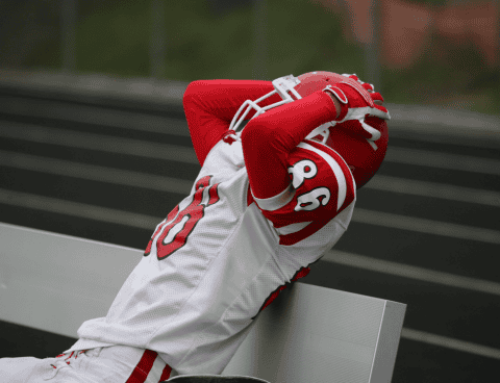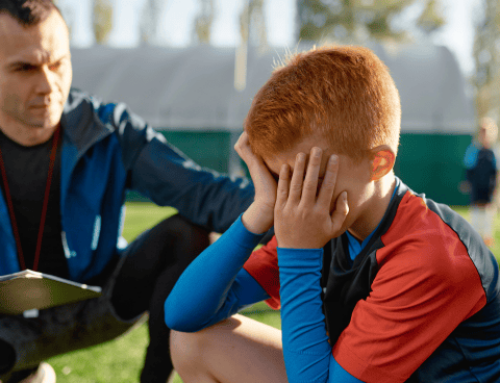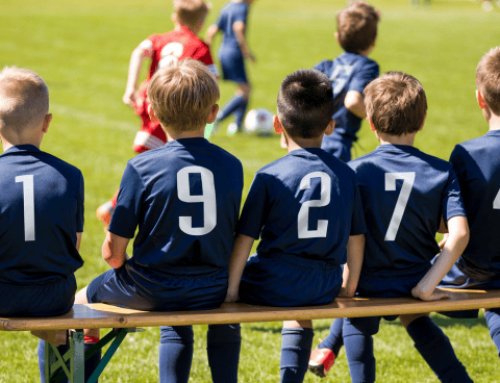Motivating students in Physical Education class is tough.
It’s something that, as a PE teacher, I honestly struggle with quite often. When you are teaching upwards of 50 students at a time, there are a lot of variables to manage when it comes to motivation.
As a teacher one of my main goals is to help students develop intrinsic motivation. It’s easier said than done when working with high school students—trust me, I know.
These five tips have helped me tremendously in my quest to make students actually care about Physical Education class.
1. Create a Welcoming Environment
As teachers, we need to create a welcoming environment by having a clean and safe space. Is the room bursting with color, light and energy?
No one wants to be in a space that’s dirty, blah or dull.
Students benefit from a clean facility that has structure and flow throughout the space. Having little things like phrases, pictures or branding on display shows what you are striving for.
For energy, is music playing to set the tone you are looking for? Go grab a speaker and get your kids feeling excited.
Although the space and music can be electric, we still need to meet the students as individuals.
2. Establish a Relationship
As teachers, we should strive to greet each student by name each day. A name is one thing that characterizes a person, so calling students by name is the first step to establishing a relationship.
As Dale Carnegie says, “a person’s name is to him or her the sweetest and most important sound in any language.”
A lot of students feel a bit of anxiety when entering a physical education environment because they think they don’t belong. Let each student know that they do belong.
Having someone welcome you and converse with you instantly can help put any student’s nerves at ease. By creating the right environment and establishing a relationship with each student, you’ll often overcome many of those initial hurdles that make many students dread PE.
3. Start with the Basics
No matter what level of students you are teaching, everyone should have a solid foundation of the basics. Starting with the basics sets the students up for success right away. It gives them that instant satisfaction needed to build confidence.
From there, students will progress at the pace at which they are ready to challenge themselves. From this foundation, students can set their own goals for what they hope to achieve next.
Goal setting helps to build confidence in a way that only they will understand. The goals should be driven by the student and no one else. As a teacher, you are there to help and guide. As they get some self-satisfaction within their goals, it will hopefully leave them wanting more.
4. Think Outside the Box. Change is Key!
After that foundation is built, challenge your students to step outside the box. Once students are ready to step outside their comfort zones, growth and development can really flourish.
I think about it like the muscular system and training. Anyone doing the same exercises or weight day in and day out will eventually reach a plateau. Only by switching up exercises, weights or style of training, can we shatter that plateau and continue making progress.
That same idea of switching things up is what we are looking for with growth and confidence in different physical education activities.
To change it up, we do game days, obstacle course challenges or team workouts. Sometimes different military branches come in to do cognitive and physical challenges with the students. We’ll even just take breaks from the workouts to talk or watch a video.
Being able to read your students’ need for change, but also knowing when to stay the course and challenge them, is a balancing act. Striking this balance will help your students remain motivated throughout the whole year.
5. Find the ‘Why?’
It is not for you, it is for them!
So, what type of activity is going to engage the intrinsic motivation and give them a “why?” to pursue a healthy lifestyle?
Is it a way to manage stress? Could it be a way to prove obesity or diabetes wrong? Do they want to make a sports team? Are they wanting a career in Kinesiology? Maybe they have been wanting to join a fitness center or a fitness class?
Everyone’s ‘why’ is going to be different, and it’s our job to help direct them to their why. PE is meant to engage and motivate students in a way that’s actually fun (Check out my breakdown of “Why” in my New Age Of PE Article).
For example, take the softball player doing weight glute bridges. I explain to her that strong glutes will help transfer to a more powerful swing. With a sentence or two, I’ve tied the day’s activity or movement to a “why” for that student. The more students I can help find their “why,” the bigger impact I know I’m having.
Patience is a Virtue. Our goal as physical educators is to promote a positive, healthy lifestyle. A lifestyle that is healthy in all aspects: physically, mentally, emotionally and spiritually.
In a society built for instant gratification, PE trains our students that patience is genuinely an important virtue for living a healthy life.
These student are our future. I want them to be able to mentally and physically take on anything that’s thrown at them, as well as to be passionate, impactful, and to have pride in what they do. That is what PE teaches!
This article was originally featured on PLT4M. PLT4M partners with over 800 high schools as an online strength and conditioning tool, delivering customizable, research-based fitness and performance programs for every level of student-athlete. STACK is proud to partner with PLT4M.
A great physical education experience starts with the right program. Learn how PLT4M can empower your students at PLT4M.com.
Photo Credit: anandaBGD/iStock
READ MORE:
RECOMMENDED FOR YOU
MOST POPULAR
Motivating students in Physical Education class is tough.
It’s something that, as a PE teacher, I honestly struggle with quite often. When you are teaching upwards of 50 students at a time, there are a lot of variables to manage when it comes to motivation.
As a teacher one of my main goals is to help students develop intrinsic motivation. It’s easier said than done when working with high school students—trust me, I know.
These five tips have helped me tremendously in my quest to make students actually care about Physical Education class.
1. Create a Welcoming Environment
As teachers, we need to create a welcoming environment by having a clean and safe space. Is the room bursting with color, light and energy?
No one wants to be in a space that’s dirty, blah or dull.
Students benefit from a clean facility that has structure and flow throughout the space. Having little things like phrases, pictures or branding on display shows what you are striving for.
For energy, is music playing to set the tone you are looking for? Go grab a speaker and get your kids feeling excited.
Although the space and music can be electric, we still need to meet the students as individuals.
2. Establish a Relationship
As teachers, we should strive to greet each student by name each day. A name is one thing that characterizes a person, so calling students by name is the first step to establishing a relationship.
As Dale Carnegie says, “a person’s name is to him or her the sweetest and most important sound in any language.”
A lot of students feel a bit of anxiety when entering a physical education environment because they think they don’t belong. Let each student know that they do belong.
Having someone welcome you and converse with you instantly can help put any student’s nerves at ease. By creating the right environment and establishing a relationship with each student, you’ll often overcome many of those initial hurdles that make many students dread PE.
3. Start with the Basics
No matter what level of students you are teaching, everyone should have a solid foundation of the basics. Starting with the basics sets the students up for success right away. It gives them that instant satisfaction needed to build confidence.
From there, students will progress at the pace at which they are ready to challenge themselves. From this foundation, students can set their own goals for what they hope to achieve next.
Goal setting helps to build confidence in a way that only they will understand. The goals should be driven by the student and no one else. As a teacher, you are there to help and guide. As they get some self-satisfaction within their goals, it will hopefully leave them wanting more.
4. Think Outside the Box. Change is Key!
After that foundation is built, challenge your students to step outside the box. Once students are ready to step outside their comfort zones, growth and development can really flourish.
I think about it like the muscular system and training. Anyone doing the same exercises or weight day in and day out will eventually reach a plateau. Only by switching up exercises, weights or style of training, can we shatter that plateau and continue making progress.
That same idea of switching things up is what we are looking for with growth and confidence in different physical education activities.
To change it up, we do game days, obstacle course challenges or team workouts. Sometimes different military branches come in to do cognitive and physical challenges with the students. We’ll even just take breaks from the workouts to talk or watch a video.
Being able to read your students’ need for change, but also knowing when to stay the course and challenge them, is a balancing act. Striking this balance will help your students remain motivated throughout the whole year.
5. Find the ‘Why?’
It is not for you, it is for them!
So, what type of activity is going to engage the intrinsic motivation and give them a “why?” to pursue a healthy lifestyle?
Is it a way to manage stress? Could it be a way to prove obesity or diabetes wrong? Do they want to make a sports team? Are they wanting a career in Kinesiology? Maybe they have been wanting to join a fitness center or a fitness class?
Everyone’s ‘why’ is going to be different, and it’s our job to help direct them to their why. PE is meant to engage and motivate students in a way that’s actually fun (Check out my breakdown of “Why” in my New Age Of PE Article).
For example, take the softball player doing weight glute bridges. I explain to her that strong glutes will help transfer to a more powerful swing. With a sentence or two, I’ve tied the day’s activity or movement to a “why” for that student. The more students I can help find their “why,” the bigger impact I know I’m having.
Patience is a Virtue. Our goal as physical educators is to promote a positive, healthy lifestyle. A lifestyle that is healthy in all aspects: physically, mentally, emotionally and spiritually.
In a society built for instant gratification, PE trains our students that patience is genuinely an important virtue for living a healthy life.
These student are our future. I want them to be able to mentally and physically take on anything that’s thrown at them, as well as to be passionate, impactful, and to have pride in what they do. That is what PE teaches!
This article was originally featured on PLT4M. PLT4M partners with over 800 high schools as an online strength and conditioning tool, delivering customizable, research-based fitness and performance programs for every level of student-athlete. STACK is proud to partner with PLT4M.
A great physical education experience starts with the right program. Learn how PLT4M can empower your students at PLT4M.com.
Photo Credit: anandaBGD/iStock
READ MORE:











